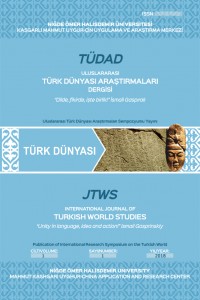Araştırma Makalesi
Yıl 2018,
Cilt: 1 Sayı: 1, 44 - 51, 01.08.2018
Öz
Barış
ve iktisadi gelişmeyi gerçekleştirmek isteği, küreselleşme ve uluslararası
bütünleşmenin gittikçe derinleşmekte olduğu modern dönemde dünyadaki tüm
devletlerin başlıca ilgi alanı durumundadır. Şangay İşbirliği Örgütü (ŞİÖ), Çin
ve Rusya başta olmak üzere, Orta Asya’daki sınır komşularıyla Sovyetlerin
parçalanmasıyla ortaya çıkan güvenlik sorunlarına ortak çözüm getirmek ve bölgesel
istikrarı korumak amacıyla kurulmuştur. Bu çalışmada, ŞİÖ’nün kurulduğundan
günümüze dek nasıl sürekli genişleme içerisinde olduğu tarihi verilere
dayanarak açıklanmaktadır. Ayrıca, Avrasya’da istikrarın korunması, iktisadin
kalkınması, ticari, teknoloji vb. alanlardaki bölgesel gelişmeler ve
işbirliğinin artmasındaki önemi tartışılmıştır.
Anahtar Kelimeler
Kaynakça
- Anna Matveeva and Antonio Giustozzi (2008), The ŞİÖ: a Regional Organisation in The Making, Crisis States Research Centre, LSE. Camilla.T.N.Sorensen, Ekaterina Klimenko (2017), “Emerging Chinese–Russian Cooperation in The Arctic: Possibilities and Constraints”, SIPRI Policy Paper, No. 46. Chen Huanyin, Liu Zaiqi (2012), “Lùn Shànghǎi Hézuò Zǔzhī Duì Zhōngguó Anquán de Zhànlüè Yìyì”, Academic Exploration, Jul. 2012 No. 7.p.39-43. Chen Xiaoqin (2010), “Guānyú Shēnhuà Shànghǎi Hézuò Zǔzhī Qūyù Jīngjì Hézuò de Sīkǎo”, International Forum Mar . , 2010, Vol . 12, No. 2, p.13-17. Gaofei (2010), “Shanghai Cooperation Organization and China’s New Diplomacy”, Netherland İnstitute of International Relations, Clingendael. Julie Boland (2011), Ten Years of the Shanghai Cooperation Organization: A Lost Decade? A Partner for The U.S.?, Foreign Policy , Brookings. Karen Smith Stegen (2015), “Understanding China’s Global Energy Strategy”, International Journal of Emerging Markets, No.10 (2), p.194 – 208. Michael Fredholm (2013), “The Shanghai Cooperation Organization and Eurasian Geopolitics”, NIAS Press NIAS – Nordic Institute of Asian Studies Asia Insights series, No. 2 United Kingdom. Nicklas Norling, Niklas Swanstrom (2007), “The Shanghai Cooperation Organization, Trade, and The Roles of Iran, India and Pakistan”, Central Asian Survey (September 2007) 26 (3), p.429–444.Rana Hasan (2017), Meeting Asia’s Infrastructure Needs, Asian Development Bank, Mandaluyong City, Philippines. Roman Mogilevskii (2012), “Trends and Patterns in Foreign Trade of Central Asian Countries”, University of Central Asia, Institute of Public Policy and Administration, WORKING PAPER NO.1, 2012.Sun Zhuangzhi (2017), “Shànghǎi Hézuò Zǔzhī Kuò Yuán yǔ Chéngyuán Guó Jiān de Jīngjì Hézuò”, Ōu Yà Jīngjì, 2017 Nián Dì 5 Qi.ŞİÖ, (2018), The Shanghai Cooperation Organisation, Erişim Adresi: http: //eng.sectsco.org/about_ŞİÖ/. Thomas Zimmerman (2015), The New Silk Roads: China, the U.S. and the Future of Central Asia, Center on International Cooperation, New York University. Vladimir Paramonov (2005), “China & Central Asia: Present & Future of Economic Relations”, Conflict Studies Research Centre, May 2005, 05/25 (E). Wang Shuqun, Wan Qingsong, (2012), “ Shànghǎi Hézuò Zǔzhī Yǔ Ou Yà Jīngjì Gòngtóngtǐ de Guānxì Tànxī ”, World Economics and Politics, No 3,2012 p.20-38. Wayne M. Morrison (2018), China’s Economic Rise: History, Trends, Challenges, and Implications for The United States, Congressional Research Service, US.Yu Jianhua (2012), “Āfùhàn Wèntí yu Shànghai Hézuò Zuzhī”, Xīyǎ Fēizhōu, 2012 Nián Dì 4 Qī.Zhangbo (2014), “A Study on Turkey’s Relations with Shanghai Cooperation Organization”, Arab World Studies, Nov.2014, No.6.p.70-82.
Yıl 2018,
Cilt: 1 Sayı: 1, 44 - 51, 01.08.2018
Öz
Kaynakça
- Anna Matveeva and Antonio Giustozzi (2008), The ŞİÖ: a Regional Organisation in The Making, Crisis States Research Centre, LSE. Camilla.T.N.Sorensen, Ekaterina Klimenko (2017), “Emerging Chinese–Russian Cooperation in The Arctic: Possibilities and Constraints”, SIPRI Policy Paper, No. 46. Chen Huanyin, Liu Zaiqi (2012), “Lùn Shànghǎi Hézuò Zǔzhī Duì Zhōngguó Anquán de Zhànlüè Yìyì”, Academic Exploration, Jul. 2012 No. 7.p.39-43. Chen Xiaoqin (2010), “Guānyú Shēnhuà Shànghǎi Hézuò Zǔzhī Qūyù Jīngjì Hézuò de Sīkǎo”, International Forum Mar . , 2010, Vol . 12, No. 2, p.13-17. Gaofei (2010), “Shanghai Cooperation Organization and China’s New Diplomacy”, Netherland İnstitute of International Relations, Clingendael. Julie Boland (2011), Ten Years of the Shanghai Cooperation Organization: A Lost Decade? A Partner for The U.S.?, Foreign Policy , Brookings. Karen Smith Stegen (2015), “Understanding China’s Global Energy Strategy”, International Journal of Emerging Markets, No.10 (2), p.194 – 208. Michael Fredholm (2013), “The Shanghai Cooperation Organization and Eurasian Geopolitics”, NIAS Press NIAS – Nordic Institute of Asian Studies Asia Insights series, No. 2 United Kingdom. Nicklas Norling, Niklas Swanstrom (2007), “The Shanghai Cooperation Organization, Trade, and The Roles of Iran, India and Pakistan”, Central Asian Survey (September 2007) 26 (3), p.429–444.Rana Hasan (2017), Meeting Asia’s Infrastructure Needs, Asian Development Bank, Mandaluyong City, Philippines. Roman Mogilevskii (2012), “Trends and Patterns in Foreign Trade of Central Asian Countries”, University of Central Asia, Institute of Public Policy and Administration, WORKING PAPER NO.1, 2012.Sun Zhuangzhi (2017), “Shànghǎi Hézuò Zǔzhī Kuò Yuán yǔ Chéngyuán Guó Jiān de Jīngjì Hézuò”, Ōu Yà Jīngjì, 2017 Nián Dì 5 Qi.ŞİÖ, (2018), The Shanghai Cooperation Organisation, Erişim Adresi: http: //eng.sectsco.org/about_ŞİÖ/. Thomas Zimmerman (2015), The New Silk Roads: China, the U.S. and the Future of Central Asia, Center on International Cooperation, New York University. Vladimir Paramonov (2005), “China & Central Asia: Present & Future of Economic Relations”, Conflict Studies Research Centre, May 2005, 05/25 (E). Wang Shuqun, Wan Qingsong, (2012), “ Shànghǎi Hézuò Zǔzhī Yǔ Ou Yà Jīngjì Gòngtóngtǐ de Guānxì Tànxī ”, World Economics and Politics, No 3,2012 p.20-38. Wayne M. Morrison (2018), China’s Economic Rise: History, Trends, Challenges, and Implications for The United States, Congressional Research Service, US.Yu Jianhua (2012), “Āfùhàn Wèntí yu Shànghai Hézuò Zuzhī”, Xīyǎ Fēizhōu, 2012 Nián Dì 4 Qī.Zhangbo (2014), “A Study on Turkey’s Relations with Shanghai Cooperation Organization”, Arab World Studies, Nov.2014, No.6.p.70-82.
Toplam 1 adet kaynakça vardır.
Ayrıntılar
| Birincil Dil | Türkçe |
|---|---|
| Bölüm | Makaleler |
| Yazarlar | |
| Yayımlanma Tarihi | 1 Ağustos 2018 |
| Yayımlandığı Sayı | Yıl 2018 Cilt: 1 Sayı: 1 |


